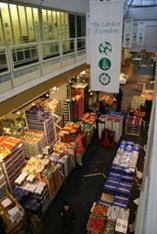
New Covent Garden Market is working in partnership with the South East England Development Agency to develop a more regionally-based business model that has elasticity and thrives on not being one-size-fits-all.
Helen Evans of the Covent Garden Market Authority told Commercial Grower that the two organisations are on the brink of inking a co-operative deal that would fund a study into the feasibility of a locally-driven market, moving NCGM towards being a ‘regional hub’.
Which isn’t to say that the traditional functions of New Covent Garden will be supplanted. But Evans sees several areas where local seems to work better than national-international approach. Roughly put, these are: ‘demand substitution’, niche approach, the accelerating demand for freshness.
At present, there are still many examples of missing links in supply.
“Wild garlic leaves,” Evans suggests. “The demand for them is tiny, not large enough for the multiples, but it’s still there. Right now, distribution is by small private companies or by growers themselves. Which obviously means a lot of ‘white van man’ miles, small drops around London, which are punitively expensive. Mushrooms, too. The supermarkets stock the basics, but it’s uneconomical for them to offer a full spectrum of varieties.
“What we would offer would be a hub: using our present distribution chain and salesforce to make it profitable to sell that sort of exotic produce.”
Building on the themes of autonomy and freshness, she sees a role for growers to sell-on directly from the market.
“In the olden days, they used to call them farmer-tenants. We want to bring back something of that model: having growers as stallholders, selling their wares straight from the van.”
Those artisans making niche food products of the sort generally confined to Borough market will also have their place in the Covent Garden sun. There will likely be space for the distribution of exotica like home-made pestos and preserves.
Part of what Evans envisions is for the market to act as a sort of ‘rightsized’ Brakes or 3663, taking advantage of the capital’s 12,000 eateries. Chefs, she argues, know what they want, and are prepared to pay for freshness to a level that supermarkets can’t.
“For instance, if you’re a chef and you run out of lemons Brakes et cetera aren’t going to deliver you just that. But we can, because we’re approximately the right size.”
In a chorus that’s become familiar to market-watchers, Evans laments the lack of co-ordination between growers, distributors and retailers. She envisages creating for a forum for the three to iron out very practical problems, very practically.
“We’re not looking for flash Powerpoint presentations. We’d want to get them to sit down over a bacon sandwich and a cup of tea, and talk openly about their issues, develop a list of very practical faults and fixes.”
Allied to this, she sees a lot of room for co-ordinating product development to out-compete foreign sources.
“I was taking a group of French leafy salad growers around the market not too long ago, and they were telling me that they’ve noticed a dip in their sales to the UK. English growers are starting to take up things like oak leaf lettuce, and win. What we would do, would be to identify more scientifically what other markets English growers could compete in that they aren’t presently. Obviously, but there’s a lot of ‘demand substitution’ that can still happen’.”
The agreement between NCG and SEEDA is to be based on matching funding for a person or persons to take charge of a study. The overall aim is to develop a ‘three year plan’ for boosting revenues from the South East.
Growers complain constantly about being squeezed by the retail multiples, yet Evans is convinced a local-first ‘hub’ model can offer growers both autonomy and increased profitability.
“The traditional perception of wholesale markets is as a dumping ground. We’re not that. What we’re saying is: plot your revenues. Put it to the test. While you won’t get the same sort of bulk-purchase undertaking as you would from a retailer, we’re convinced that growers can achieve higher returns longer-term via this model.”



